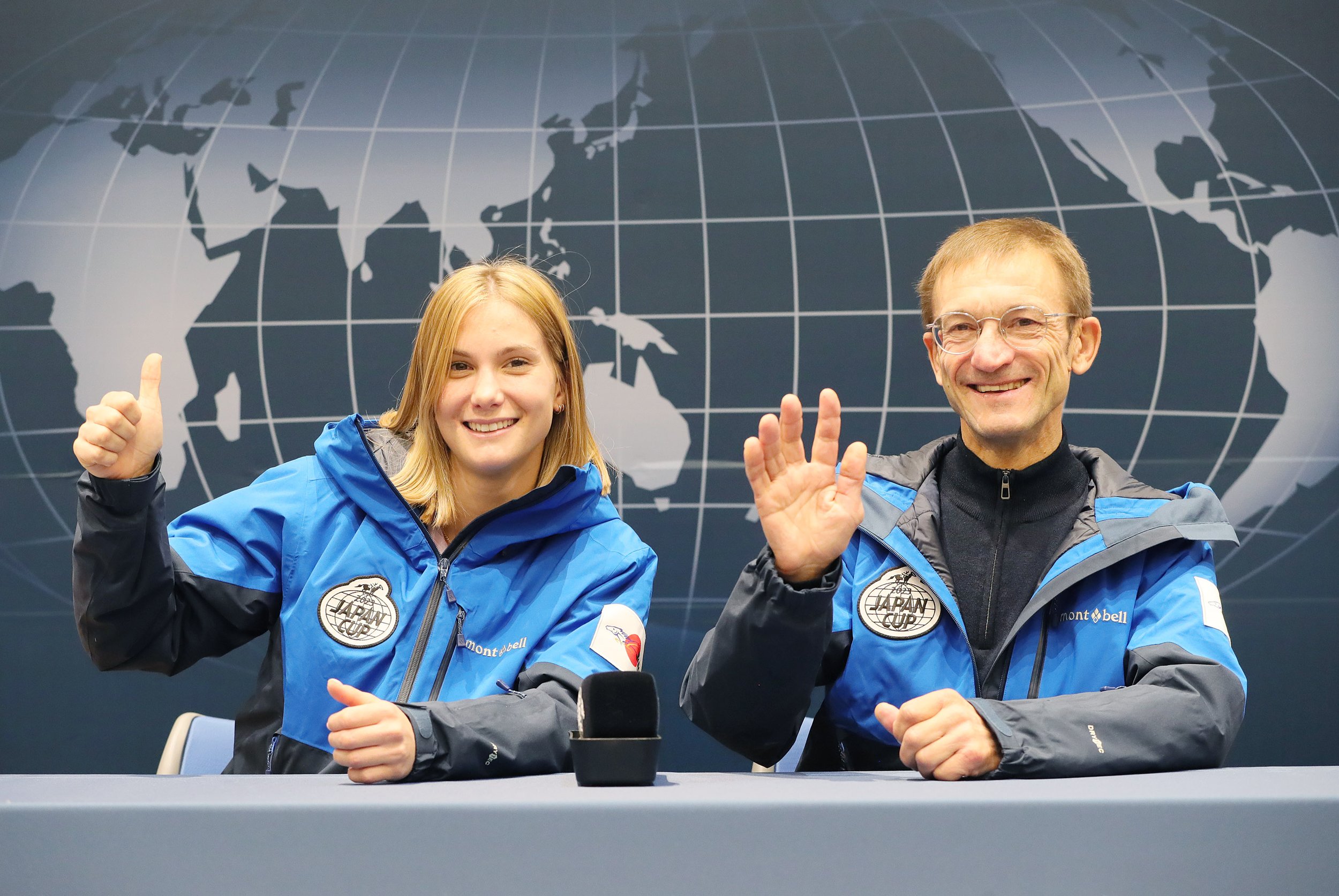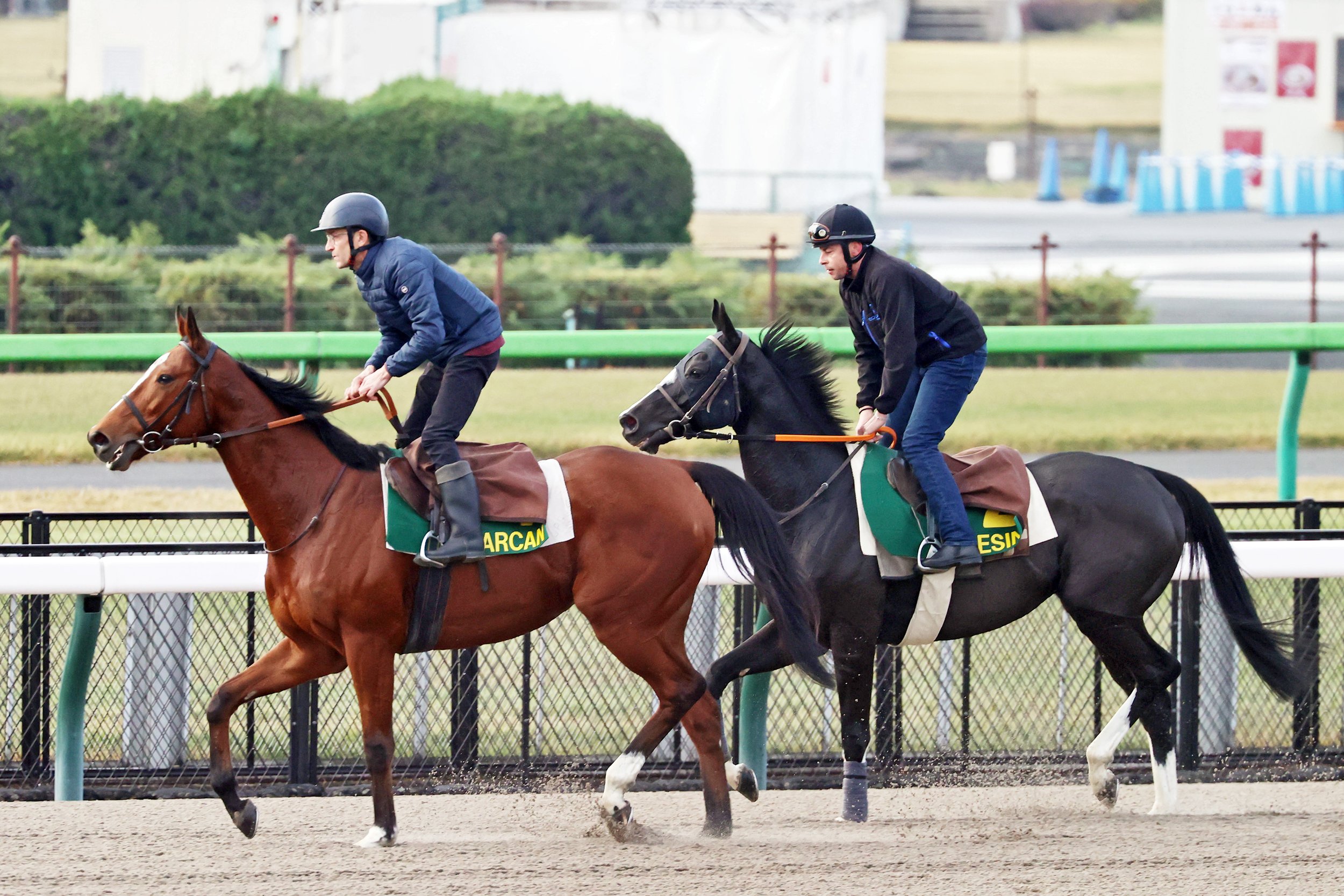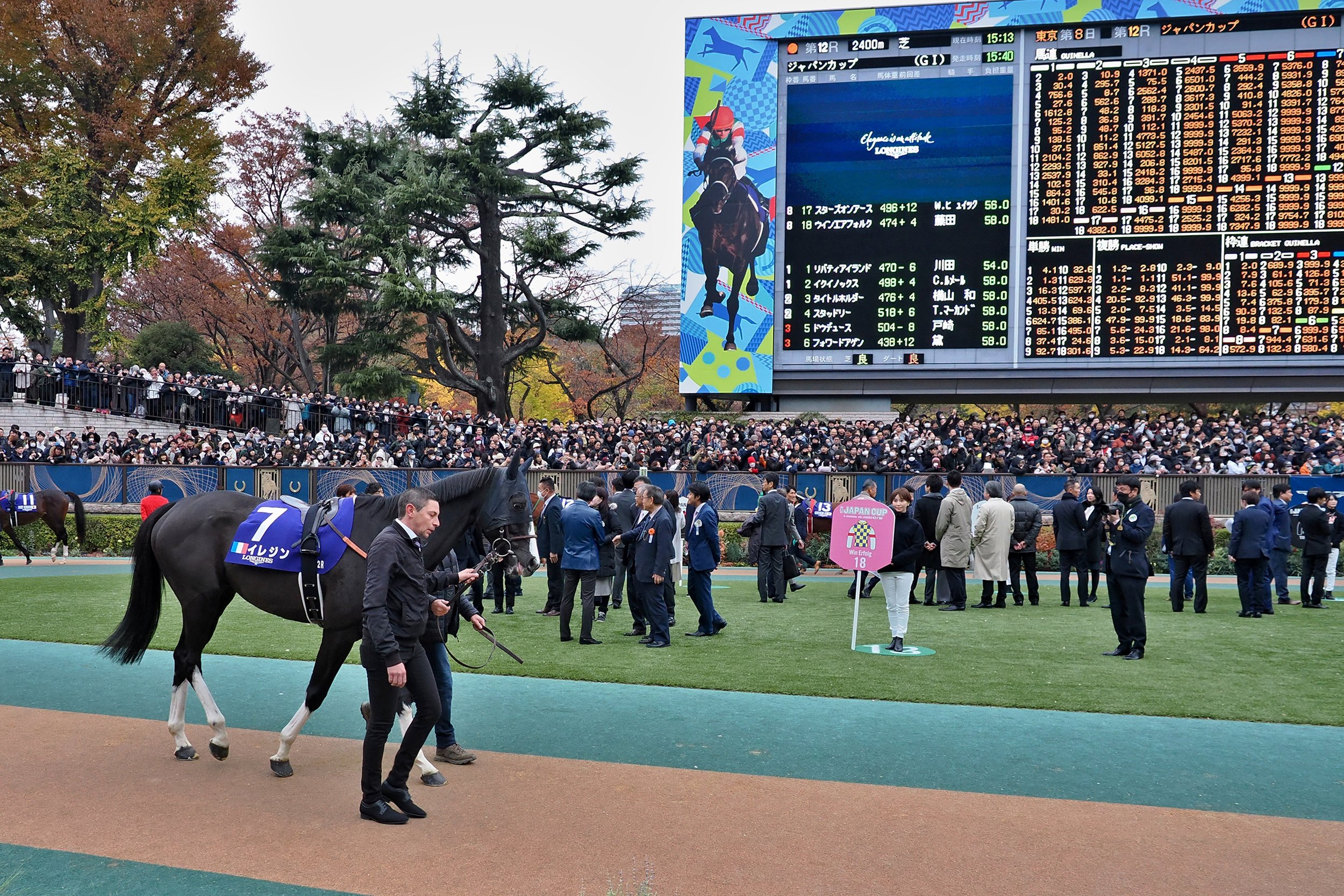Tokyo Calling – Documenting Iresine’s journey from rural France to the Japan Cup
Article by Katherine Ford
This is the fairytale of a Japanese adventure for a team of family and friends who could never have anticipated being treated like emperors in Tokyo as privileged guests of the JRA.
Iresine, a six-year-old gelding who cost just €6000 as a yearling before climbing the ranks to a pair of Group 1 successes in France, brought the dream to life for hands-on trainer Jean-Pierre Gauvin, France’s leading lady jockey Marie Velon and a group of low-key owners and supporters eager for the experience of a lifetime.
Rags to riches stories are nothing new to Jean-Pierre Gauvin, famed in France as the handler of Saonois, the “Cheval du Boulanger”, who was bought for a song and won the 2012 Prix du Jockey-Club for local baker Pascal Treyve, and renowned for his success with the unfashionably-bred mare Siljan’s Saga, multiple Group 1 placed and 4th at 100/1 in the 2016 Arc.
Winner of the Prix Royal-Oak in 2022 and Prix Ganay in 2023, his latest star, Iresine, has been high on the wish list of the Japan Racing Association for the Japan Cup for many months and this autumn, Gauvin decided the time was right.
“Ever since last year, the JRA French representative Soichiro Matsumae, has been encouraging us to run in the Japan Cup! He has done a good job! As a six-year-old gelding he has the right profile to travel to Asia and the date of the Japan Cup is ideal before he goes on his winter break.”
Family Connections
“Above all the aim is to enjoy the adventure. My son and daughter are co-owners of the horse and they are both coming, as well as my grandson who is just 18 months old, my wife, my brother who is a co-owner too, plus another brother who lives in the USA. If it hadn’t been for Iresine, we would never have undertaken such a trip as a family.”
60 year-old Gauvin is a horseman through and through. Born and raised in the Centre-East region of France by parents who “like many farmers in the region, had a couple of trotting broodmares. At age 15 I went to the apprentice school to learn the trotting trade but at only 33kg, I was advised to try the flat!” Except for a brief stint in Marseille, he has spent his entire career, from apprentice to trainer, at the stable he still occupies in the rural hamlet of Saint-Cyr les Vignes.
With limited facilities but plenty of turnout paddocks and a hands-on approach, Jean-Pierre Gauvin is not afraid to test alternative routes, and was not deterred by conditions in Tokyo.
“The ground will be fast and the competition will be very tough, but if we only raced when everything was in our favour and we were sure to win we’d never go anywhere. The JRA agreed to all our requests, including the possibility of taking a companion horse, so there was no reason not to go!”
JRA Generosity
“For Iresine’s participation, the JRA offer the same bonus as for the winner of the Prix de l’Arc de Triomphe and other bonus races, of which the Ganay is not one. He will receive $200,000 just for participating, plus there is prize money down to tenth place. So from a financial perspective, it represents a considerable sum even if we finish tenth. It’s an adventure but the organisation has been perfect. Now the final concern is the travel, which after a change of plan from Air France, will be from Frankfurt to Tokyo. I’m looking forward to Eric calling me to tell me that all has gone well.”
Eric Vandra, Gauvin’s travelling head lad, is about to undertake his second far-flung journey with a horse as he was present when Saonois ran (10th) in Hong Kong 11 years earlier. A former jockey who left racing twice only to return each time, he is determined to ensure that all goes smoothly with Iresine.
“We’re going on an adventure. But there are already details which reassure me. On the plane Iresine will be accompanied by Edouard Lyon who is a trainer but does some work for the STH transport company. I used to be an apprentice for his father and looked after Edouard when he was a kid. All these years later, we meet again on a plane to Japan, and it’s him who will be looking after me!
Iresine will come off the horsebox and be stabled for a few hours in Frankfurt airport, then the flight to Tokyo takes about 14 hours. He’s a horse who can be nervous when he travels, and it seems he inherits his stressed nature from his dam. I didn’t know her in training but we have got to know Iresine’s breeders and they have told us about her character.”
Vandra has prepared 250kg of equipment to travel with Iresine and stablemate Marcan, “I’ve tried to think of every eventuality. Having been to Hong Kong, I know more or less what we’ll need, and of course the most important thing is the passport!”
All the foodstuff has already been taken care of, as Jean-Pierre Gauvin explains, “The JRA requested a full inventory of all our feed, plus any complementary products, because nothing can come off the plane with Iresine. The JRA supply everything, and this will be either the equivalent product from Japan, or imported items if necessary.”
Vandra continues, “The JRA have explained what it will be like over there. We have to leave our riding clothes in the quarantine area, there are showers on site and we have to wash and change before leaving the stable complex. The protocol is very strict. I’ve seen some photos, it all looks very new.”
Indeed, the equine import procedure for the Japan Cup has been simplified with the opening in 2022 of a new quarantine stable in the infield of Tokyo racecourse, eliminating the need for horses to respect a quarantine period at a separate site upon arrival in Japan before moving on to Tokyo days later.
Nerves fraying early in the week
Iresine travelled “perfectly” to Japan but after clearing quarantine gave trainer Jean-Pierre Gauvin a major scare. At a press conference for “international visiting horses” three days before the race, the eyes of around 100 media and other onlookers were all focused upon connections of sole visitor, Iresine.
“On Monday, Iresine suffered from tying up syndrome after his work.”, the trainer explained with refreshing transparency. “He got nervous when going through the tunnel to access the track, but then he cantered fine. Back at the stable, all seemed to be OK initially but then he started to tie up as we took him to wash down. I was very worried but the vet took a blood test and we treated him, essentially to rehydrate him. On Tuesday he had to undergo his stalls test so we had no choice but to take him through the tunnel again, but we led him through in hand and mounted him on the other side, and he reassured us with his exercise. All went smoothly again on Wednesday and today (Thursday) he was completely back to himself, asking to go faster. His coat is shiny again and he looks happy to be here.”
The same can be said for his trainer, who was out on the track each day aboard lead horse Marcan. “I would have come here just for the opportunity to ride out at this amazing racecourse!” he joked to an interested reporter.
In addition to the assembled media, Team Iresine had taken time out from sightseeing to attend the training session and press conference. “I’ve never seen so many media in all my life. Wow!” exclaimed wide-eyed co-owner Bertrand Millière. “For small owners like us, we weren’t programmed to have a horse like this. At the sales, he didn’t have the profile to end up where he is today. But as is often the case with the Gauvin method, he has climbed the ladder step by step. Each time we just said “wow”, but he has never stopped progressing and now here we are in Japan, the centre of attention of a crowd of journalists. We are living in a dream and are making the most of it.”
Another co-owner is Jean-Pierre’s brother, trotting trainer Jean-Paul Gauvin, “I’m on a different planet, even further than the moon! I wanted to have horses in training with Jean-Pierre to share experiences, but I was thinking of small provincial race tracks at home, we never imagined ending up here. The two disciplines, trotting and flat, are so different, but we do take ideas from each other and I think that Jean-Pierre has gained a lot of inspiration from the trotting world. We exchange a lot, notably about shoeing… It’s an opportunity for us to talk, because we both have all-consuming jobs. Training is more than a passion, it’s a way of life, and having horses with Jean-Pierre gives us an opportunity to see each other and share emotions. We’re making the most of it at 200%, visiting Tokyo, enjoying good food and discovering a whole new world.”
“Iresine is a champion. He has a huge heart and a great attitude. It wasn’t written on him at the sales.. or else we wouldn’t have been able to buy him so cheaply. But Jean-Pierre has a real horseman’s intuition. Don’t forget he also picked out Saonois and Siljan’s Saga. Saonois cost €8000, “Siljan” just €2500 and she finished fourth in the Arc. That’s proof that you can always dream with horses, and here we are!”
Bargain buy from novice breeders
Jean-Pierre Gauvin goes on to explain the purchase of Iresine, for €6000 at Arqana’s October yearling sale. “He caught my eye in the collecting area before entering the ring. He had four white stockings which is often considered to be a negative but Bertrand Millière’s children fell in love with his markings and we were able to buy him cheaply.”
Breeders Marie-Louise Van Dedem and her husband Pierre Joyaux are also part of the support team in Tokyo and Dutch-born Marie-Louise remembers, “Iresine was the first generation to be born at our Haras de Grandouet in Normandy and he always had a lot of personality. The Haras de Montaigu presented him at the sale and Jean-Pierre Gauvin was the only one to show any interest in the horse. I didn’t know him at the time, but Aliette Forien (of Haras de Montaigu) said to me after the sale, “you did the right thing to let him go at that price, as he is a very good trainer.””
Like the rest of the team, Marie-Louise Van Dedem was far from imagining that one day she would be invited by the JRA as a connection of a Japan Cup runner. “I became a breeder by chance, and we bought the property on (resale website) Le Bon Coin and built it from scratch. My husband Pierre bought Iresine’s dam and he chooses the matings. I remember early on he explained to me about the Group race system and I didn’t understand a thing! But I’ve learnt quickly and do everything now. It’s all about observation and attention to detail.”
More drama as dream almost turns to nightmare
Attention to detail is a maître-mot for the JRA who cannot receive enough praise from Jean-Pierre Gauvin and his team, especially after a second unwelcome setback. “On Friday evening, as Iresine was being led out, he wasn’t sound. We couldn’t believe it, another problem after him tying up on Monday,” recounts Vandra.
Jean-Pierre Gauvin received the bad news just moments before attending the Japan Cup gala event, “it was a difficult moment at the formal dinner as I would have preferred to be at the stable close to the horse, but I had a lot of confidence in the JRA veterinary team. The vet proposed solutions but also listened to our suggestions. We always agreed about the best treatment to adopt.”
After fears of an infection were discounted, confidence grew that Iresine would make the starting line after all. “He had leather pads on all four feet. These can have a tendency to harden and one of them had become distorted, making a lump which was putting pressure on the sole. In agreement with the veterinarian, we applied a linseed poultice, and on Saturday morning, even without his shoe he trotted out sound. The blacksmith was superb, he is the son of the best farrier in Japan, and I even heard that he shoes Equinox. He reshod Iresine, taking care to avoid pressure on the sensitive part, and things soon worked out. But it was a worry as we were less than two days from the race.”
“For me, the victory is that we were able to run,” says Vandra, “it didn’t look good during the week. The JRA teams did everything they could to help us.”
A memorable occasion for a united team
Come raceday, in a state of relief, excitement and wonder, the team of co-owners, breeders and trainer were welcomed into a private box overlooking Tokyo’s gigantic track and stands filled with 85,000 fans. Jockey Marie Velon’s parents, who live close to the Gauvin stable, were also part of the supporting group throughout the week. “Marie turned up one morning at the stable after finishing her apprenticeship with Alain de Royer Dupré, and until recently worked for me whenever racing allowed. She has grown with Iresine and this is her adventure too,” says Gauvin before adding with emotion, “I am her racing dad. I was touched the day she came out with that…”
As is the way in Japan, horses enter the parade ring 35 minutes before the race, giving fans time to digest all the information available on the giant screens and admire their champions before placing a bet and taking position in the stands. Focus is on favourite Equinox, the Longines World’s Best Racehorse, but there is respect and admiration for the foreign visitor.
“In the parade ring, the only noise I could hear was of cameras clicking all the way around for 15 minutes,” recalls Vandra. “The public are real fans; they must have taken hundreds of photos, and I’ve received some of them. They love their racing and are pleased to have an international horse in the race.”
In what will be remembered as an iconic edition of the Japan Cup, won in superlative style by the world champion Equinox, Iresine ran credibly to finish ninth.
“He ran honourably. It’s difficult to say whether the complications affected his performance, but Marie was happy with how he ran and he recorded his best time over the distance of 2400m.”
For his efforts, connections take home to France the $200,000 participation bonus plus €107,000 for ninth place. But far more important than the prize money, Iresine’s Japan Cup was an unforgettable team adventure.
“We would have liked to stay longer… We all had an incredible experience, both professionally and personally… We were the only international horse so maybe they made an extra effort for us, but the support from the JRA was second to none. Day by day, within our group, we reassured each other about the likelihood of being able to race, which wasn’t guaranteed at times, and despite the worries we were able to relax and enjoy the week together.”
After Iresine landed back in France safe and sound several days after the Japan Cup and began his annual winter break in the Puy de Dome, the final word goes to his trainer, “Merci Iresine!”, or should that be Arigatou Iresine?










